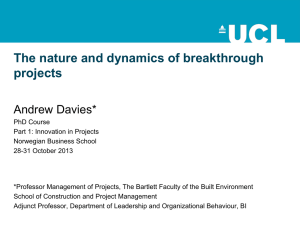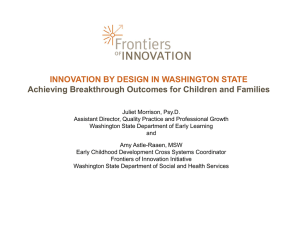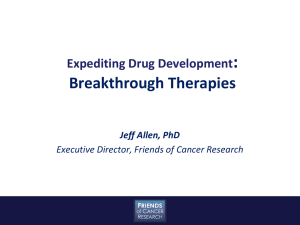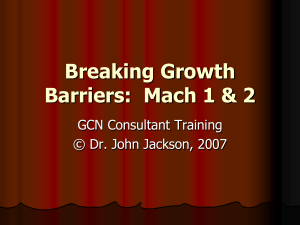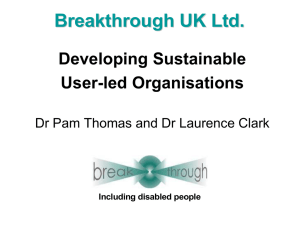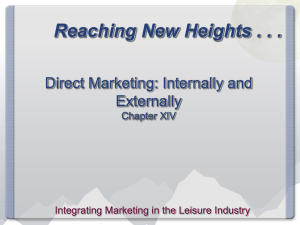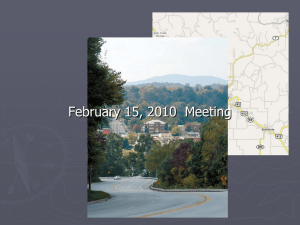Chapter 1 Breakthrough
advertisement
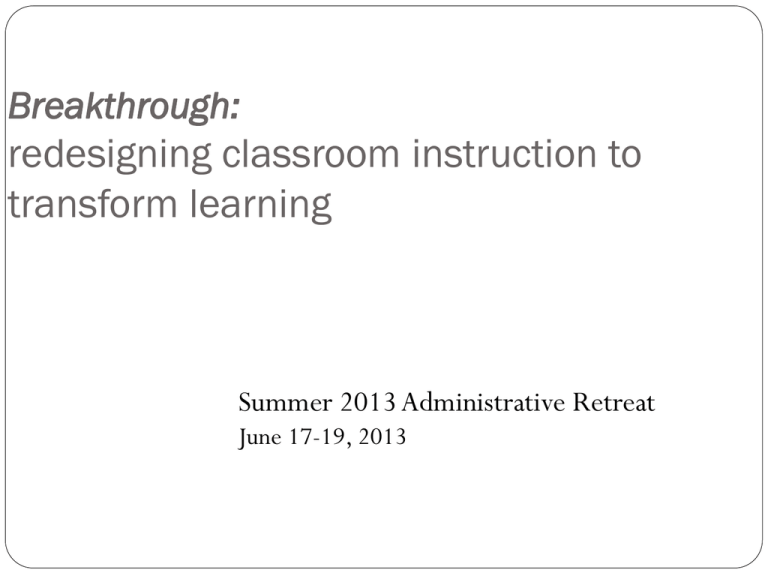
Breakthrough: redesigning classroom instruction to transform learning Summer 2013 Administrative Retreat June 17-19, 2013 Against all odds you create breakthrough. Reflection/Interaction (A tale of two cultures) Today’s Meet (Curriculum Depot) Day 1 Day 2 Day 3 Twitter #psrcadmin2013 Objectives • Linking Breakthrough thinking to your goals • Challenge our Beliefs and Understandings through the lens of Moral Purpose • Explore the Triple ‘P’ Core Components • Explore the BREAKTHROUGH Framework • THE NEXT STEP: Critical Learning Instructional Paths (CLIPs) Leading Student Achievement • Professional learning communities: raising the bar for student achievement and closing the learning gap Opening Activity 1) Take 5 minutes as a table to brainstorm the crucial components, ideas and values or “puzzle pieces” to a breakthrough in education! 2) Come to a consensus on 18 puzzle pieces and use the markers at the table to fill in the slots. Leave the center slot open. 3) If you have time, someone at the table take a picture of the poster and send a tweet using #psrcadmin2013 “Breakthrough is about linking all the core pieces of the puzzle-without our framework, educators often have many of the pieces , but they come from different puzzles. No wonder people cannot make a picture!” Breakthrough page 20 Breakthrough Leadership • Understanding of PLC’s and their impact on student achievement • Increasing use of meaningful data • Moving from surface collegiality to a more intense culture focused on student outcomes • Understanding of the role of the principal as an instructional leader • Applying S.M.A.R.T goals Breakthrough thinking •Transformation of thinking about classroom instruction •Requires change of thinking about the educational research enterprise •Requires a ‘tri-level’ approach to transforming classroom instruction Making Connections…… BREAKTHROUGH QUESTION What are the critical components for a Breakthrough system to take off in your school? …let’s explore that together Chapter 1 A New Mission for School Systems “Mistakes…. are the portals of discovery.” James Joyce #psrcadmin2013 In-between Stories A System Stalled Joseph Campbell in a discussion with Bill Moyers in The Power of Myth talks about the tipping point or “breakthrough” struggles societies have when they are in-between stories. “The old story sustained us for a long time-it shaped our emotional attitudes, it provided us with life’s purpose, it energized our actions, it consecrated suffering, it guided education. We awoke in the morning and knew who we were, we could answer the questions of our children. Everything was taken care of because the story was there. Now the old story is not functioning. And we have not yet learned a new” What are the struggles we are facing today to create our story in which we accomplish the following: “The breakthrough we are seeking involves the education community as a whole establishing a system of expert data-driven instruction that will result in daily continuous improvement for all students in all classrooms.” breakthrough page 2 ; lines 6-9 Use the border of your puzzle to list struggles that impact or stall a breakthrough. Are some of the identified struggles the same terms used as the essential pieces of the puzzle? Share your thoughts with Twitter using #psrcadmin2013 The Power of Failure Can we use our mistakes and failures as a guide in writing a new story? Although Breakthrough was written BCC (Before Common Core) the reference to a needed national reform is uncannily close to what has come to fruition! Lets look at the following points and check for current relevance regarding key problem areas in education today: “Failure to establish classroom routines and practices that represent Personalized, Ongoing, Data-Driven, Focused Instruction.” 1. 2. “Instructional goals were more often articulated in terms of student outcomes or achievement levels .” “There is nothing more difficult to address than the case where people think that they are doing something when in reality they are not.” breakthrough page 6 ; lines 10-12 Very few conversations connect changes in the standards with changes in instruction. As an instructional leader what has been your most difficult challenge in sparking this conversation? Think across all levels…. World, Nation, State District, Community School, Home After a moment of personal reflection, place a dot in one or more of the identified puzzle pieces that is directly connected/related to that difficult conversation! What informs or “drives” our Feedback? "The most important single factor influencing learning is what the learner already knows. Ascertain this and teach ... accordingly." (David Ausubel, 1968) Do you agree with this quote...? Why does this bold statement hold water? If you do not agree, what is the most important factor influencing learning ? Share your thoughts with Twitter using #psrcadmin2013 Breakthrough basic beliefs are founded on the moral purpose of education, not just for students but for teachers as well. Nonnegotiable beliefs All students can achieve high standards, given sufficient time and support. All teachers can teach to high standards, given the right conditions and assistance. High expectations and early intervention are essential. Teachers need to learn all the time, and they need to be able to articulate both what they do and why they do it. The Prescription Trap “we need to go from broad strokes to specific action without falling into the trap of prescription” An Easy Solution.... • When we prescribe we are treating the symptom not the cause. • Prescription may seem like a viable solution; for we are sharing what “worked for me” with the notion that if replicated the same results should be achieved! What is one educational program prescription you have given or received and stopped due to adverse side effects? Share at your table Triple ‘P’ Core Components Chapter 2 - Breakthrough BREAKTHROUGH In a nutshell… • Most educational reform has resulted in modest gains in student learning and little or no impact on daily teaching • We need to transform instruction through a focus on personalization, precision and professionalism (TRIPLE ‘P’ CORE COMPONENTS) • This means giving teachers the assessment and analysis tools, the organizational structures and the expert systems that link data on each student to daily decisions about what to teach, how and when • It also means changes to how we conceptualize the research enterprise, how systems align their work and the kind of leadership exerted at all levels. Triple ‘P’ Core Components Personalization Precision Moral Purpose Professional Learning Page 15 - Breakthrough TRIPLE ‘P’ CORE COMPONENTS • For innovation to flourish: • all three components, not any two, will be required; • the cost must be practical; • and the benefits must be experienced on a wide scale… BREAKTHROUGH criteria • The GLUE that binds the three is MORAL PURPOSE • The three P’s must be synergistically interconnected TRIPLE ‘P’ CORE COMPONENTS • For innovation to flourish: • all three components, not any two, will be required; • the cost must be practical; • and the benefits must be experienced on a wide scale… BREAKTHROUGH criteria • The GLUE that binds the three is MORAL PURPOSE • The three P’s must be synergistically interconnected MORAL PURPOSE : BELIEFS and UNDERSTANDINGS • All students can achieve high standards given sufficient time and support • All teachers can teach to high standards given the right conditions and assistance • High expectations and early intervention are essential • Teachers need to be able to articulate what they do and why they do it (theory based rather than trade based) Hill & Crévola,1997 HOPE Hope is not the same thing as optimism. It is not the conviction that something will turn out well, but certainly that something makes sense, regardless of how it turns out. It is hope, above all, that gives us strength to live and to continually try new things, even in conditions that seem hopeless. V. Havel, 1990 SHARE • What were some of the barriers? • What were some of the suggestions for actions? PERSONALIZATION • Personalization is the least developed of the three components • Caroline Tomlison (1998) …personalization ‘puts the learner at the center’ • Engagement with schooling declines as students go up the grades…inadequate linkages of the other two P’s…precision and professional learning PERSONALIZATION Personalization is about individuals PERSONALIZATION Personalization must be for ALL ‘In the absence of pervasive personalization, the opposite will happen - mass production, one-size-fits-all mentality that fits those who benefit from the status quo.’ Fullan, Hill & Crévola, 2006 (pp 17) PRECISION • To be precise is to get something right • To prescribe is to lay down rigid rules • Precision is in the service of personalization: being precise to the learning needs of the individual • ‘assessment for learning’ has helped PRECISION The fatal weakness remains: going from assessment to instruction Fullan, Hill & Crévola, 2006 PRECISION Taking the analyzed data and using it to inform instruction is easy to say but evidence shows that it is very rarely done effectively within the classroom context. ‘Schools need to get assessment for learning out of the basement, clean it up, and creatively recombine it with personalization and continuous professional learning.’ Fullan, Hill & Crévola, 2006 PRECISION • Educators have assessments, but they are often selected from bits of this and that, small pieces of the whole. • Increasingly teachers are being helped to analyze the data. • The missing step and next piece is to make sense of the whole thing as one unified picture of where each student lies in terms of where to go next Reflection Changing the Conversation BREAKTHROUGH FRAMEWORK Fullan, Hill & Crévola, 2006 Areas of Focus 1)Leadership 2)Quality Teachers 3)Instructional Support In Summary Table Talk…… Refer to pages 88-89 During the next 15 minutes to reflect on your assigned topic to discuss. Post highlights of your conversation on either Today’s Meet or Twitter (don’t for get to put #psrcadmin2013 at the end of your tweet)
